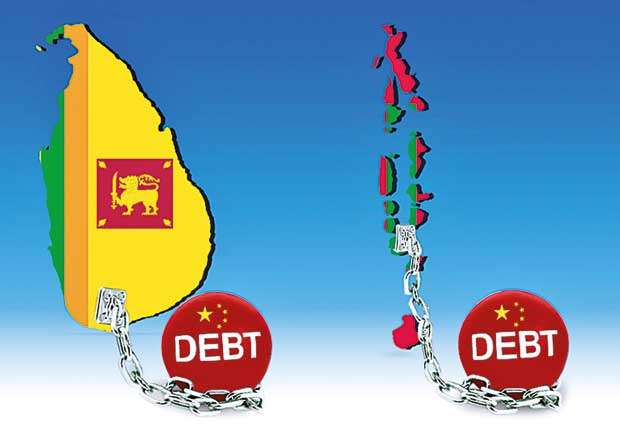Reply To:
Name - Reply Comment
Last Updated : 2024-04-26 02:12:00

Sri Lanka’s foreign debt is again talk of the town. Is the country overly indebted to China? Are we borrowing too much from international capital markets? Or are we financing ourselves into trouble with multi-lateral agencies like the International Monetary Fund (IMF), World Bank (WB) and Asian Development Bank (ADB)? And how do we assess the role of foreign financing for economic development?
Economic growth and prosperity requires investment. And investment can either be funded through savings or borrowings. Investment may come from household savings in banks or taxes that are not used for recurrent state expenditure. If households do not save enough and the Government does not tax enough, then external borrowings must fund investment to increase production and employment. To avoid a foreign debt trap, the Government should impose adequate levels of taxation or, alternatively, ensure it is in a position to borrow from domestic private savings to finance national plans and related investment.
savings or borrowings. Investment may come from household savings in banks or taxes that are not used for recurrent state expenditure. If households do not save enough and the Government does not tax enough, then external borrowings must fund investment to increase production and employment. To avoid a foreign debt trap, the Government should impose adequate levels of taxation or, alternatively, ensure it is in a position to borrow from domestic private savings to finance national plans and related investment.
At present, this story is complicated by past foreign loans that remain unsettled, which also require more foreign borrowings to make principal and interest payments. This is the debt trap that is worrying the country at the moment. How does the Government roll over past foreign loans? Is it by borrowing from international capital markets in the forms of sovereign bonds? Or bilateral donors such as China, Japan and India? Or multi-lateral agencies such as IMF, WB and ADB?
Sri Lanka’s accumulated external debt stock was at US$ 28.7 billion at the end of 2017, where market borrowings mainly of sovereign bonds accounted for 39%, and loans owed to ADB 14%, Japan 12%, WB 11%, China 10% and India 3%. In addition, many loan agreements in the form of Official Development Assistance have been made over the last five years with disbursements yet to be made for a total of US$ 9 billion. Of these undisbursed loans by bilateral and multilateral donors, and this does not include market borrowings that are not agreed to in advance, China leads the pack with 22%, followed by Japan and ADB with 19%, WB with 13% and India with 6% (Finance Ministry Annual Report 2017).
It is easy to point fingers at regional powers that have contributed to Sri Lanka’s foreign debt problems, whether China, Japan or India. However, as I have previously argued, the biggest culprit is borrowings from global finance capital or the seemingly innocent international capital markets, which charge much higher interest rates.
As evident from repeated financial crises over the last few decades – most recently in Southern  Europe – the consequences of international market borrowings can be devastating. And yet, IMF, WB and ADB, want Sri Lanka to open its capital markets to global finance capital, which comes with the dangers of capital inflow and flight causing crises. IMF uses the stick of the Extended Fund Facility Agreement of 2016 towards that end, while ADB and WB use the carrot of hundreds of millions of US dollars in development assistance to expand capital markets—most recently, ADB’s Capital Market Development Programme (US$ 250 million) and WB’s Financial Sector Modernization Project
Europe – the consequences of international market borrowings can be devastating. And yet, IMF, WB and ADB, want Sri Lanka to open its capital markets to global finance capital, which comes with the dangers of capital inflow and flight causing crises. IMF uses the stick of the Extended Fund Facility Agreement of 2016 towards that end, while ADB and WB use the carrot of hundreds of millions of US dollars in development assistance to expand capital markets—most recently, ADB’s Capital Market Development Programme (US$ 250 million) and WB’s Financial Sector Modernization Project
(US$ 75 million).
While the data above speaks for itself, why is it that there is so little discussion of Sri Lanka’s market borrowings characterized by sovereign bonds? Is it because we like to believe we are at the centre of the world with China, India and the US fighting over us? Or have we fallen for the bias of Western and regional media, which paint Sri Lanka as a pit stop in the geopolitical game, and overlook the devastation that comes with neoliberal integration of capital markets.
If mega development and trophy projects under the Rajapaksa regime pushed Sri Lanka deeper into a debt trap of foreign loans, the current Government is digging itself deeper by seeking mega development projects with international financing to increase GDP growth and shore up its external finances in the short-term. Here again, Chinese funded projects such as the Port City have been in the limelight, but projects by multi-lateral agencies face little scrutiny.
The ADB funded Northern Province Sustainable Fisheries Development Project is estimated at US$ 174 million, with over a third of that amount being spent on the Point Pedro Harbour. Compare this with the Budget 2018 allocation of Rs. 150 million (less than US$ 1 million) to rebuild the Myliddy fishery harbour, currently underway in northern Jaffna. The Myliddy harbour is also more appropriate for the small scale fishing community in the North, rather than the Point Pedro harbour meant for large deep sea fishing vessels. Even more striking is that the ADB “project design advance” for consultants is US$ 1.59 million of which US$ 0.29 million comes from the Government. In other words, the consultancy fees for an internationally financed fishery project is higher than the total allocation for a national project to rebuild a major fisheries harbour, exemplifying the gravy train of funds for international consultants, perks for local officials and windfall profits for contractors involved in internationally financed development projects.
A second example is the ADB water project for Jaffna, running into hundreds of millions of US dollars. An “interim solution,” on the order of US$ 80 million is required for a desalination plant to be built on the eastern coast of Jaffna to supply desalinated sea water at many times the cost of supplying river or tank water from the mainland to parts of the peninsula.
The sad reality, according to many in Jaffna, is that we let rain water run into the sea and then use reverse osmosis to convert sea water into fresh water. Perhaps we have ambitions of becoming Saudi Arabia or Israel, but neither do we live in a desert nor are we that wealthy! Crazy as these development projects may sound, they are increasingly the norm in many debt-ridden countries at the mercy of multi-lateral agencies.

Add comment
Comments will be edited (grammar, spelling and slang) and authorized at the discretion of Daily Mirror online. The website also has the right not to publish selected comments.
Reply To:
Name - Reply Comment
US authorities are currently reviewing the manifest of every cargo aboard MV
On March 26, a couple arriving from Thailand was arrested with 88 live animal
According to villagers from Naula-Moragolla out of 105 families 80 can afford
Is the situation in Sri Lanka so grim that locals harbour hope that they coul